105: Building a Highway Needs Tools and Construction Workers For an Efficient Pathway
Hosted By: Diana Spencer, Rebecca Graham, Dr. Bruce Davis, Lorie Golden


Instructional Level: Introductory
We have learned many many tools are needed in our toolboxes to build a highway: collaboration, follow-up, planning, commitment, patience, and understanding. These all “appear” to be simple concepts but are they? Are they equal or more difficult when using them to seek resilience and independence with someone with IDD and a co-occurring mental health diagnosis. Do we need bulldozers and excavators as well for the “bigger jobs”? How does one create effective support plans, sustainable success. learning opportunities, and relationships? We have drilled down to the foundational elements needed to create this highway; an efficient pathway leading home. We have discovered creating a pipeline between individuals, leadership, and teams is critical to planning. Highways are complex, they have intersections and hubs. As persons travel along this highway, they might need to adapt to a detour sign, navigate a fork in the road, prepare for a traffic jam, or collide with a misconception. But building the highway is worth the risk. When the highway is completed, emotions become regulated, acceptance is had, persons are empowered, and perspectives are heard. The highway makes it easier to travel interactively with friends, family and supporters. The panel will address questions related to the tools and machines needed to build a sustainable highway and how they have used them effectively and efficiently to make actionable requests and advancements.
Learning Objectives:
- Understand building a highway requires tools and workers collaborating to make advancements in resilience.
- Identify ways to navigate working with leadership and teams to use tools effectively and efficiently.
- Recognize factors others have used in planning blueprints so perspectives are heard and successful adaptations made.

